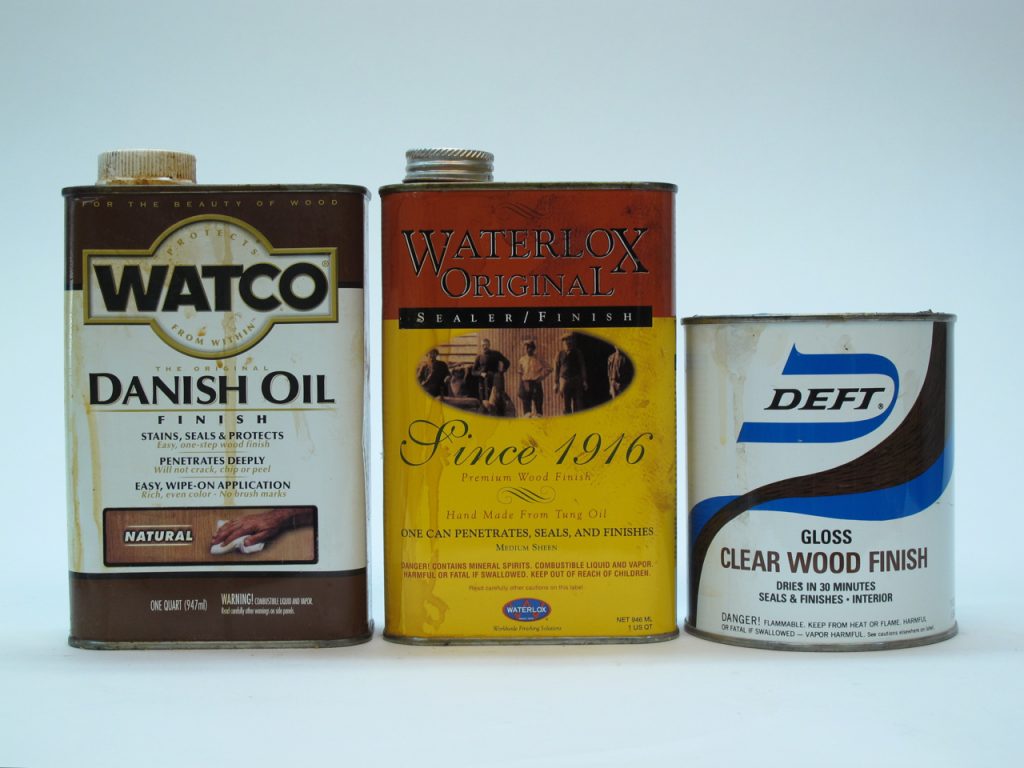We may receive a commission when you use our affiliate links. However, this does not impact our recommendations.

Watco, Waterlox and Deft are known by their brand names alone.
Like Kleenex, which is just one brand in the tissue category, some finishing products are known just by their brand name, not by what they are. This leaves room for misunderstanding. Watco, Waterlox and Deft are prime examples.
All three were made popular in the late 1970s by numerous mentions in Fine Woodworking magazine. The descriptions of what they are were vague and sometimes incorrect. For example, Watco was (and still is) often described as thinned varnish, Waterlox was (and still is) often described as tung oil, and Deft was represented as a mystery finish, unique in that it was different from other finishes.
Once in print misrepresentations are hard to eliminate. But it’s worth a try. So, for the record, here’s what these finishes really are.
Watco is a mixture of drying oil, probably linseed oil, and varnish, with a lot of thinner added. As a result of the oil part of the mix, Watco is not a very protective finish because the oil keeps the finish from drying hard. This prevents you from building the finish to any functional thickness. You have to wipe off all the excess after each coat or the finish will remain soft and sticky. But Watco is a very easy finish to use, and it produces a nice warm effect on the wood, so it is a popular finish.
Waterlox is a wiping varnish, which means that it is varnish thinned about half with mineral spirits (paint thinner). Even though thin, it can be built to a thickness on the wood with enough coats because it dries hard. Waterlox is fairly unique among common varnishes in that it’s made by cooking phenolic resin with tung oil, rather than alkyd resin with modified soybean oil like most other varnishes. Phenolic resin and tung oil are darker than alkyd resin and modified soybean oil, so the finish has a darker color than other varnishes.
(Note that Watco is a “mixture” of oil and varnish while Waterlox is oil and resin that are cooked to create something different, varnish, with different characteristics.)
Deft is a brushing lacquer, which means that it is made with slower evaporating solvents than spraying lacquer so you can successfully brush it onto fairly large surfaces before it sets up. For many years, the fact that it was a lacquer was not mentioned on the can. It was simply labeled Deft Clear Wood Finish. This left the door open for the mystery to develop. Partly because of my suggestion to the company, the label now says it’s a brushing lacquer. Deft is the only company I know of that has changed its label to improve accuracy.
All three of these companies now make other finishing products, but none of these are known by their brand name alone.
Here are some supplies and tools we find essential in our everyday work around the shop. We may receive a commission from sales referred by our links; however, we have carefully selected these products for their usefulness and quality.









Deft has come out with a waterborne finish in a can that looks almost identical to the lacquer version. You have to read the fine print and not just look for the blue and white “Deft” can. I can’t post photos here, but look at the links.
https://www.amazon.com/Deft-Interior-Waterborne-Clear-Finish/dp/B000FSV844/ref=sr_1_3?hvadid=177829237105&hvdev=c&hvlocphy=9015939&hvnetw=g&hvpos=1t1&hvqmt=e&hvrand=3528412981491793512&hvtargid=kwd-13204959154&keywords=deft+waterborne+clear+wood+finish&qid=1554217836&s=gateway&sr=8-3
vs.
https://www.amazon.com/Deft-Interior-Finish-Brushing-Lacquer/dp/B000LNSGB6/ref=asc_df_B000LNSGB6/?tag=hyprod-20&linkCode=df0&hvadid=198071503086&hvpos=1o1&hvnetw=g&hvrand=2640253790528556208&hvpone=&hvptwo=&hvqmt=&hvdev=c&hvdvcmdl=&hvlocint=&hvlocphy=9015939&hvtargid=pla-511352528872&psc=1